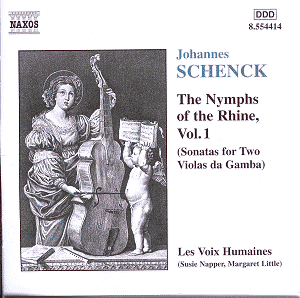Johannes
SCHENCK (1660-after 1712)
Le Nymphe di Rheno (The Nymphs of the Rhine) Op 8 Vol 1
Sonatas for 2 Violas da Gamba
 Les Voix Humaines
Les Voix Humaines
Recorded Saint-Augustine's Church, Quebec May 1997
 NAXOS 8.554414
[62.35]
NAXOS 8.554414
[62.35]
Crotchet
AmazonUK
AmazonUS

Johannes Schenck is hardly a household name so bravo to Naxos whose early
music disc roster continues to grow. This one is ample proof that the company
is now repertoire-led and not performer-led. No doubt Sussie Napper and Margaret
Little were largely instrumental in getting this music onto CD for the first
time and indeed Schenck makes his debut as far as I can tell. So who was
he?
Keith Anderson regularly writes the booklet notes for Naxos. He manages,
in about 1,000 words, to communicate the composer's life and some sensibly
detailed notes on the six sonatas in his effortlessly compact prose. Born
in Amsterdam, Schenck, he says, became "a leading virtuoso of the viola da
gamba" and that his 'Nymphs of the Rhine' is "a tribute to his patron at
the court of Dusseldorf" who was Johann Wilhelm known as Jan Wellam. It is
this grand patron of the Arts to whom Corelli dedicated his Concerti Grossi
Op 6
Schenck is presumed to have continued in the service of the Elector after
1716, but when the court moved to Mannheim some musicians stayed on in
Dusseldorf. Schenck's date of death has yet to be traced in either town or
in the records of any church.
I must admit that the prospect of 'enjoying' six sonatas for two gambas did
not at first fill me with too much excitement, but I was soon to be proved
wrong. Each sonata is fascinatingly different. The slightly French sounding
opening Adagio of the first Suite immediately captivated me. Thereafter the
music flowed as a succession of delightful miniatures. Dances in each suite
generally include an Allemanda and a Corrente; also possible is a Sarabande
or/and a Giga. If not those then a Bourrée, a Rondeau and a Minuet.
In the 5th suite there is a very short Aria Polonese in compound
duple time. Some movements have 3 tempi Allegro-Adagio-Allegro for instance.
The 3rd Suite in D major follows the pattern of a church sonata
with the usual Italian terms; it is in 3 movements with the second in three
parts and the third in two. The longest suite is No 6 in G minor, which is
in 7 movements ending with a serious but lively Giga and beginning with a
beautiful and imitative Adagio. All of this gives the infinite variety which
I spoke of and which keeps one's attention.
Everything is superbly played with perfect tempi, effortless phrasing and
ideal balance helped by the church acoustic. The virtuosity is most certainly
there but masked by the fine musicianship, the players having mastered all
demands especially in the movements which require the most expressive playing.
Some of these are the short Adagios like the delicious one in the
6th Suite and the elegant Sarabandes. There is also a very fine
Chaconne which opens the 4th Suite; at practically five minutes
it is the longest movement on the CD and reminds me of Louis Couperin (1626-1661)
or D'Anglebert (1635-1691).
All in all a very fine release of unknown repertoire which will give expert
and non-expert alike considerable pleasure.
Gary Higginson

